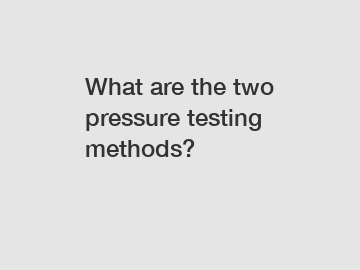What are the two pressure testing methods?
Pressure testing is a crucial process in industries such as manufacturing, construction, and oil and gas, to ensure the safety and reliability of equipment and systems. There are two main methods of pressure testing that are commonly used: hydrostatic testing and pneumatic testing. Each method has its own set of advantages and limitations, depending on the specific requirements of the application. In this article, we will explore the differences between these two pressure testing methods and when each one is most appropriate.
Hydrostatic Testing:
Hydrostatic testing is a method of pressure testing that involves filling the equipment or system with water and pressurizing it to a specified level. This method is commonly used for testing pipelines, pressure vessels, and other components that will be in contact with liquids. The test relies on the principle that water is incompressible, so any leaks or weaknesses in the system will result in visible signs of leakage.

One of the main advantages of hydrostatic testing is that it can be performed with relatively simple equipment and is relatively low-cost compared to other testing methods. It is also highly effective at detecting leaks, as the presence of water makes any leaks immediately visible. However, there are limitations to hydrostatic testing, such as the need to completely drain and dry the system after the test, as well as the potential for corrosion of metal components if not properly treated.
Pneumatic Testing:
Pneumatic testing, on the other hand, involves pressurizing the equipment or system with air or another gas, rather than water. This method is often used for testing systems that will be in contact with gases, such as air compressors, tanks, and pneumatic tools. Pneumatic testing is particularly useful for detecting leaks in systems that will be carrying gases, as any leaks will result in a loss of pressure.
One of the main advantages of pneumatic testing is that it is faster than hydrostatic testing, as it does not require the system to be drained and dried afterward. It is also less likely to cause corrosion of metal components, as air is less corrosive than water. However, pneumatic testing can be more challenging to perform, as gases are compressible and leaks may be harder to detect than with water. Additionally, there is a higher risk of injury if the system being tested fails under pressure.
When to Use Each Method:
The choice between hydrostatic and pneumatic testing depends on several factors, including the type of system being tested, the materials involved, and the specific requirements of the application. In general, hydrostatic testing is more suitable for systems that will be in contact with liquids, while pneumatic testing is better for systems that will be in contact with gases.
In conclusion, both hydrostatic and pneumatic testing are important methods for ensuring the safety and reliability of equipment and systems in various industries. Each method has its own set of advantages and limitations, and the choice between them should be based on the specific requirements of the application. If you have any questions or need assistance with pressure testing, please contact us for more information.
Contact us for more information on pressure testing methods and how we can help with your specific needs.
Contact us to discuss your requirements of high pressure booster air compressor, valve pressure testing equipment, valve test bench. Our experienced sales team can help you identify the options that best suit your needs.

Comments